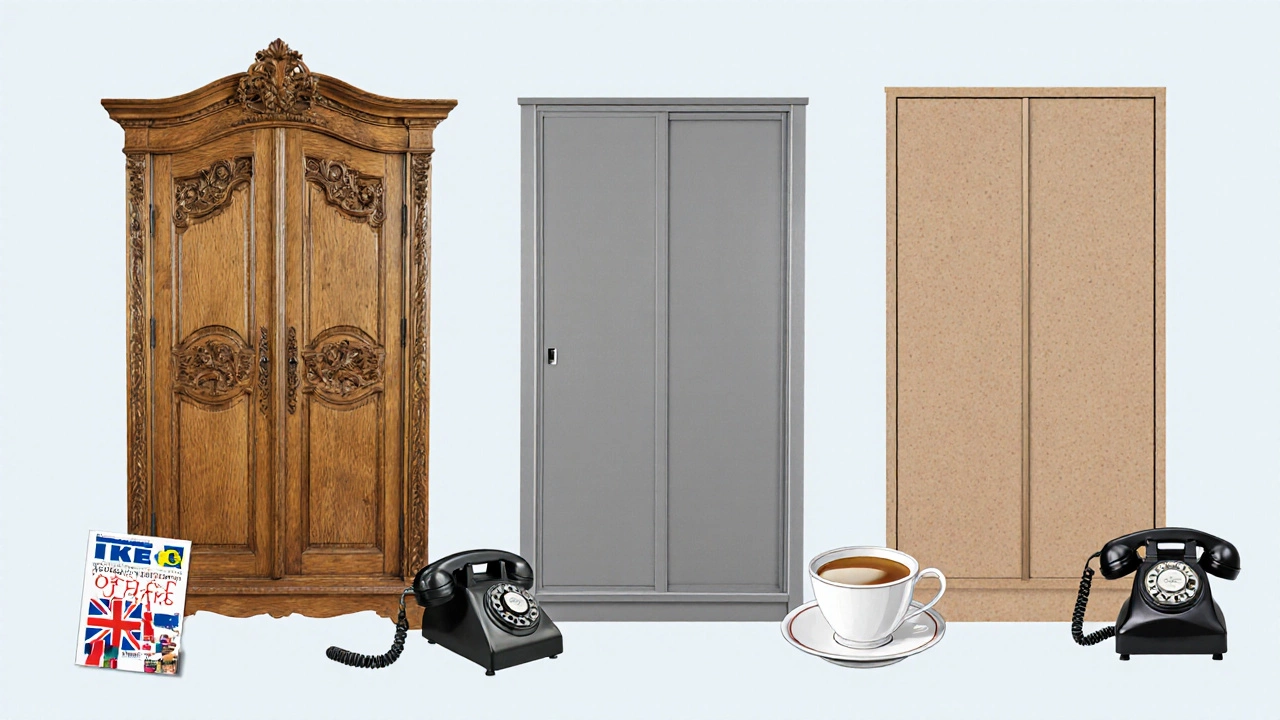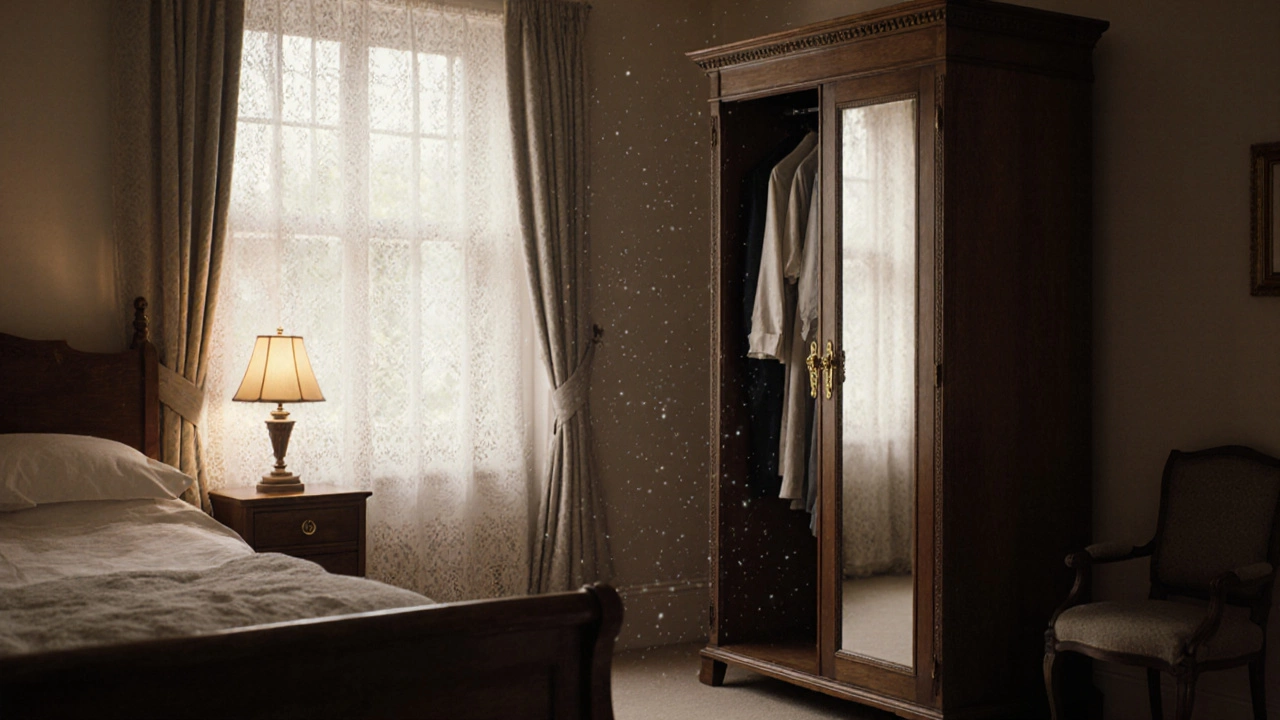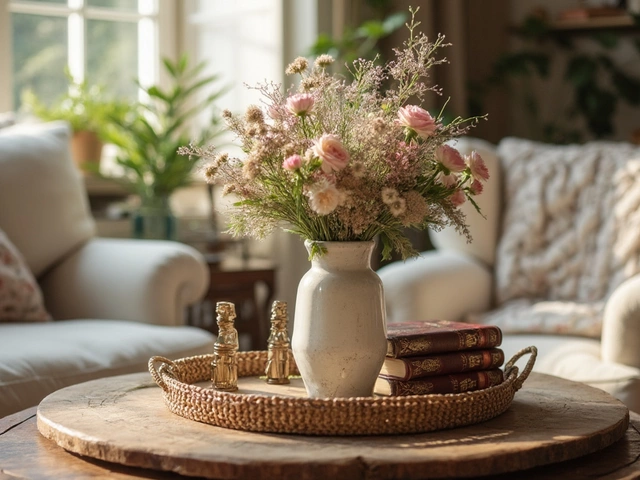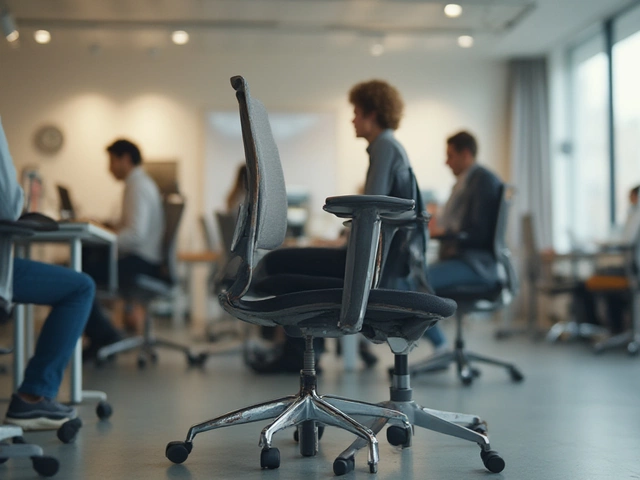UK Wardrobe vs American Closet Calculator
Enter Your Dimensions
Enter measurements in centimeters
Results
Enter your measurements to see how they compare to typical UK wardrobes and American closets.
If you’ve ever watched a British TV show or visited a home in England, you’ve probably noticed something odd: people don’t say "closet" when they mean the place where clothes hang. You might hear "cupboard," "wardrobe," or even "built-in"-but never "closet." That word? It’s mostly American. In England, if you’re looking for a place to store your shirts, jeans, and winter coats, you’re looking for a wardrobe.
Wardrobe Isn’t Just a Word-It’s the Standard
In the UK, "wardrobe" is the default term. It’s what you’ll find on every IKEA catalog, every furniture store website, and every estate agent’s property listing. Walk into a typical British bedroom-whether it’s a 1930s terraced house in Leeds or a modern flat in Bristol-and the large, freestanding cabinet with doors and hanging rails? That’s a wardrobe. No one calls it a closet. Not even in casual conversation.
Even when the storage is built into the wall, people still say "wardrobe." You might hear: "The bedroom has a fitted wardrobe" or "We’re replacing the old wardrobe with a new one." The word "closet"? It’s rarely used outside of American movies or when someone’s trying to sound fancy-or ironic.
Why Don’t Brits Say "Closet"?
The difference comes down to history and language evolution. In the 18th and 19th centuries, British homes didn’t have small, enclosed spaces inside walls for clothes. Instead, they used freestanding wooden cabinets-often tall, ornate, and made from oak or mahogany. These were called "wardrobes," from the Old French "warderobe," meaning a place to guard robes or garments.
By the time American colonists started building smaller, more compact homes in the 19th century, they began carving out small recesses in walls for clothes storage. They called these "closets"-from the Middle English "close," meaning enclosed space. The British didn’t adopt that style as widely, especially in older housing stock. So while Americans got used to sliding open a door in a wall, Brits kept the freestanding piece.
Today, even new builds in the UK often include built-in wardrobe units. But they’re still called wardrobes. The term stuck because it described the function, not the structure. It’s not about whether it’s built-in or free-standing-it’s about what it’s for.
What About "Cupboard"? Is That the Same Thing?
You might hear someone say, "I put my coats in the cupboard," and wonder if that’s the same as a wardrobe. Sometimes, yes-but only in casual speech. In the UK, "cupboard" usually refers to a smaller storage space, like the one under the stairs or in the kitchen for tins and mugs. But when it comes to clothes, "cupboard" can be used interchangeably with "wardrobe," especially in older generations or rural areas.
It’s not wrong to say "clothes cupboard," but it’s less precise. A cupboard implies shelves, drawers, maybe a door-but not necessarily hanging space. A wardrobe always has a rod for hanging clothes. If you’re buying a new storage unit for your shirts and dresses, you’re looking for a wardrobe. If you’re storing folded jumpers and scarves, a cupboard might work.

Types of Wardrobes Common in UK Homes
There are three main types of wardrobes you’ll see across England:
- Freestanding wardrobes - The classic wooden or MDF unit you roll into a room. Often found in older houses. These are still popular in rentals and smaller spaces because they’re easy to move.
- Fitted wardrobes - Built into the wall, often floor-to-ceiling. These dominate modern homes and new builds. They’re custom-made to fit alcoves or unused corners. Many come with mirrored doors, internal lighting, and pull-out drawers.
- Sliding door wardrobes - A subset of fitted wardrobes, but designed to save space. Instead of swinging open, the doors glide sideways. Very common in London flats where every inch counts.
Brands like IKEA, DFS, and Made.com all sell these styles. But if you walk into a local furniture shop in Manchester or Brighton, you’ll still find traditional wooden wardrobes with brass handles and carved detailing. They’re not just furniture-they’re heirlooms.
How to Spot a British Wardrobe (Even If You’re Not in the UK)
If you’re shopping online and want to buy something that looks authentically British, here’s what to look for:
- Look for listings that say "fitted wardrobe" or "freestanding wardrobe," not "closet"
- Check the dimensions: UK wardrobes are often narrower but taller than American ones-usually 60cm wide and 200cm+ high
- Materials: Solid wood, MDF, or laminate are common. Glass and chrome are trendy in cities, but wood dominates
- Doors: Double doors are standard. Sliding doors are common in flats
- Internal features: Look for hanging rails, adjustable shelves, and sometimes pull-out shoe racks
Don’t be fooled by American retailers listing "closets" as "British-style"-they’re usually just rebranding a standard US closet with a British-sounding photo.
What Do You Call a Wardrobe in Other Parts of the UK?
There’s little regional variation in the word itself. Whether you’re in Glasgow, Cardiff, or Norwich, everyone says "wardrobe." But there are small differences in style:
- In Scotland, you might see more traditional oak wardrobes with heavy iron hinges
- In Wales, fitted wardrobes often include built-in drawers for woolens, thanks to damp climates
- In London, minimalist, handleless sliding wardrobes are the norm
- In the North, you’ll still find sturdy, no-frills wooden units passed down through generations
The term stays the same. The design changes with the house, not the language.

Why This Matters If You’re Moving to the UK
If you’re relocating from the US, Canada, or Australia, this isn’t just a fun fact-it’s practical. When you’re house hunting, you’ll see "bedroom with fitted wardrobe" in listings. If you don’t know that means "closet," you might think the room is bare. You could even end up buying furniture that doesn’t fit because you assumed the space was meant for a US-style closet.
Also, when you’re shopping online or asking for help in a store, saying "I need a closet" will confuse staff. Say "wardrobe" and you’ll get the right product immediately.
Even Airbnb hosts in England describe their spaces using "wardrobe." If you’re booking a place and see "the wardrobe is large enough for 3 weeks’ worth of clothes," you now know what that means.
Common Mistakes Americans Make
Here’s what trips people up:
- Asking for a "closet organizer"-in the UK, you’d ask for a "wardrobe organiser" or "internal drawer system"
- Buying a tall, narrow unit and calling it a "closet"-it’s a wardrobe, even if it’s freestanding
- Assuming all storage units are the same-UK wardrobes often have deeper hanging space (65cm+) than American closets
- Thinking "cupboard" means the same thing-unless it’s explicitly for clothes, it probably isn’t
It’s not about being right or wrong-it’s about speaking the local language. And in this case, the language is "wardrobe."
Final Thought: It’s Not About the Word-It’s About the Space
At the end of the day, whether you call it a wardrobe, a closet, or a clothes cupboard, what matters is that it works. But if you want to blend in, sound local, and find the right piece of furniture without confusion, use the word the British do: wardrobe.
It’s not just a piece of furniture. It’s part of the culture. And in a country where language is tied tightly to tradition, getting the word right matters more than you think.
Do English people ever use the word "closet"?
Rarely, and usually only when quoting American media. In everyday life, "closet" sounds foreign or overly casual. Even British teenagers who watch Netflix say "wardrobe." Using "closet" in a UK furniture store will likely lead to confusion.
Is a wardrobe the same as a dresser?
No. A dresser in the UK is a chest of drawers, usually for folded clothes or accessories. It doesn’t have a hanging rail. A wardrobe has both hanging space and often drawers, but its defining feature is the rod for clothes.
What’s the difference between a wardrobe and an armoire?
An armoire is a type of wardrobe-usually more ornate, with decorative carvings or a French design. In the UK, people still call it a wardrobe, even if it’s an armoire. The term "armoire" is mostly used by designers or when describing antiques.
Are built-in wardrobes common in UK homes?
Yes. In new builds and modern flats, fitted wardrobes are the standard. Even in older homes, many people install them to maximize space. Freestanding wardrobes are still common in rentals and period properties.
Can I buy a wardrobe in the UK if I’m from the US?
Absolutely. UK wardrobes are widely available online and in stores like IKEA, DFS, and local furniture shops. Just make sure to check dimensions-UK wardrobes are often narrower and taller than American ones. Also, the electrical outlets and plug types are different if you’re bringing over a lighted wardrobe.



